Abolitionist Movement
Introduction
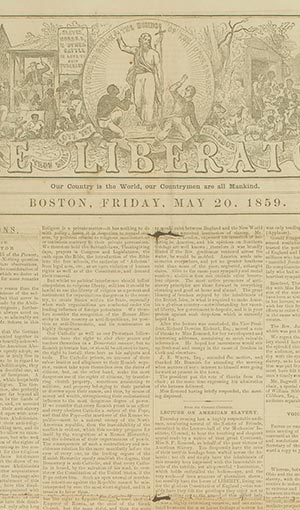
From the 1820s until the outbreak of the Civil War, no segment of the reading public was spared from the arguments and opinions concerning slavery and abolition. In one year alone (1837-1838), the American Anti-Slavery Society published 7,877 bound volumes; 47,256 tracts and pamphlets; 4,100 circulars; and 10,490 prints.
In 1831, William Lloyd Garrison (1805-1879), founded an anti-slavery newspaper entitled The Liberator. His rhetoric provided a voice for the abolitionist movement: I am in earnest – I will not equivocate – I will not excuse – I will not retreat a single inch – AND I WILL BE HEARD.
In 1851, the voices of abolition found outlet in the influential novel by Harriet Beecher Stowe, Uncle Tom’s Cabin. It appeared first as a serial in the anti-slavery periodical, The National Era, from June 1851 to April 1852. When released in book form, it sold 300,000 copies in the United States in its first year.
Evidence & Artifacts
 View 7 images
View 7 images
The Seer. Washington City, D.C. April 1854. p. [241]
The prophecy on war was published for the first time in the United States in Washington, D.C. in the periodical The Seer edited and published by Apostle Orson Pratt.
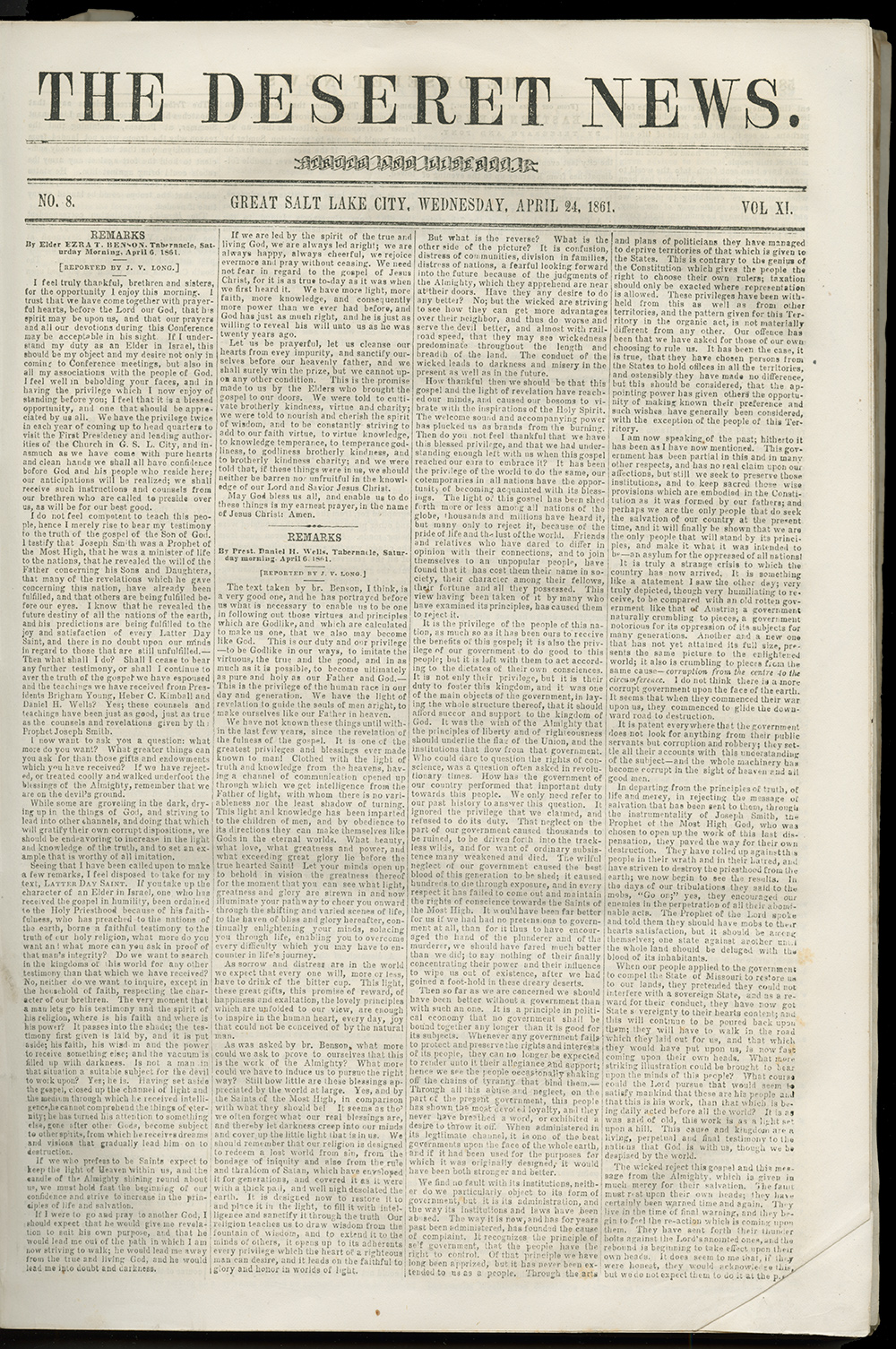 View 5 images
View 5 images
The Deseret News. Great Salt Lake City, Wednesday, April 24, 1861. Vol. 11, no. 8.
Word of the commencement of hostilities in South Carolina arrived in Salt Lake City via Pony Express on Saturday, April 20th just 8 days after the first attack on Fort Sumter, Charleston, South Carolina, on Friday, April 12th, 1861. This news was published for the first time to Utahns in the Deseret News on Wednesday, April 24, 1861.
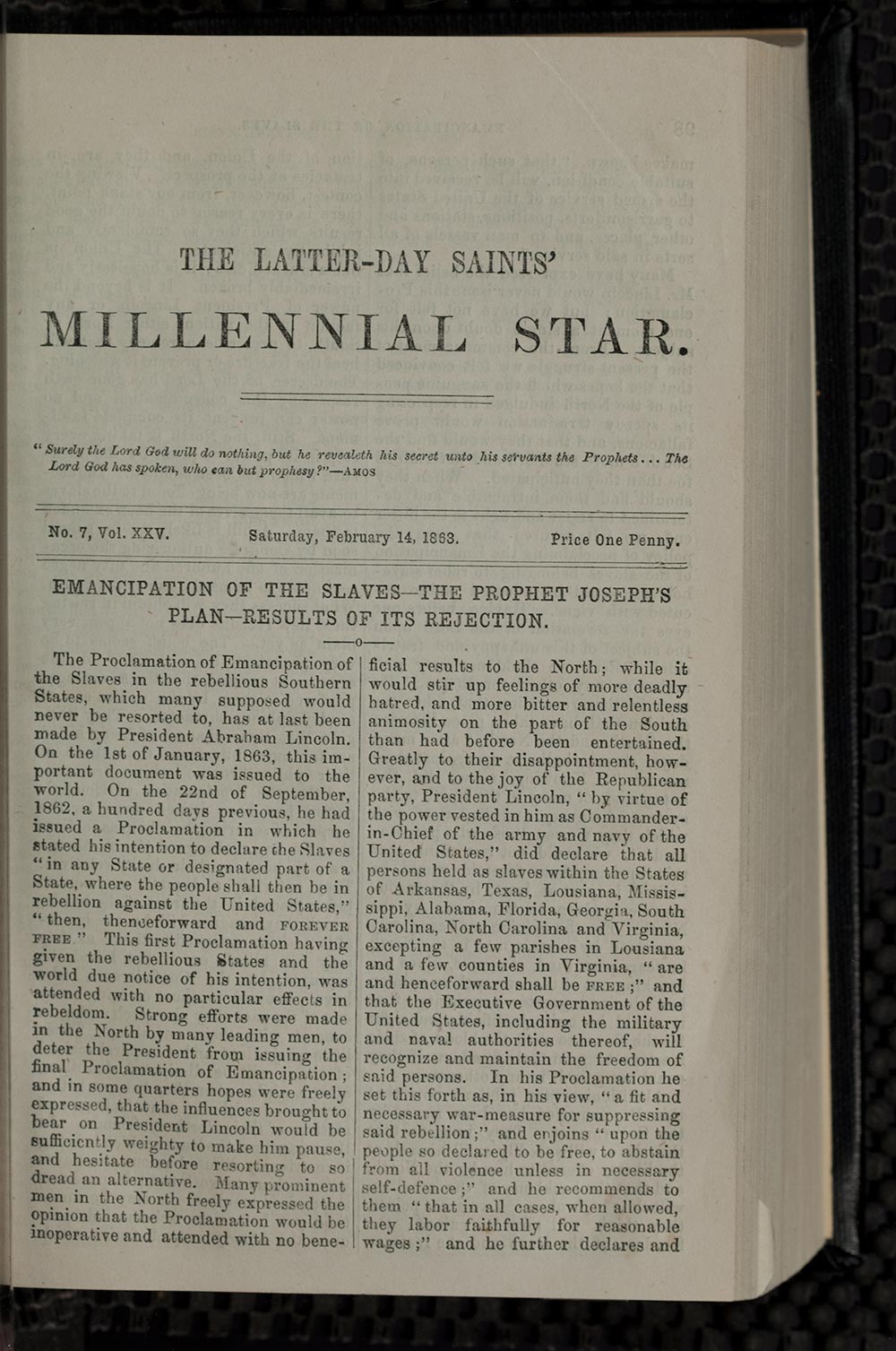 View 5 images
View 5 images
George Q. Cannon, “Emancipation of the slaves—The Prophet Joseph Smith’s plan — Results of its rejection.” The Latter-day Saints’ Millennial Star. Vol. 25 (Saturday, February 14, 1863): [97]-101.
By 1863 it was the view of many Mormons, including Apostle George Q. Cannon, then editor of the Millennial Star, that the Southern States would reject the Emancipation Proclamation (which became law on 1 January, 1863) and that rejection would pave the way for the fulfillment of one of the details of Joseph Smith’s war prophecy, namely,
“after many days slaves will rise up against their masters.”
To the Mormons, a bill before the U.S. Congress was a specific fulfillment of Joseph’s prophecy:
“A bill is likely to be passed soon by Congress authorizing the organization of one hundred and fifty negro regiments to be used against the South”
Cannon also reminded the world in this article that:
“Seventeen years before [in 1844] the outbreak of the present dreadful difficulty the Lord inspired his servant Joseph Smith to put himself forward in his right as an American citizen, as a candidate for President of the United States . . . had his views been received and adopted by the nation, how different would their position have been at present!” (1863). p. 100.
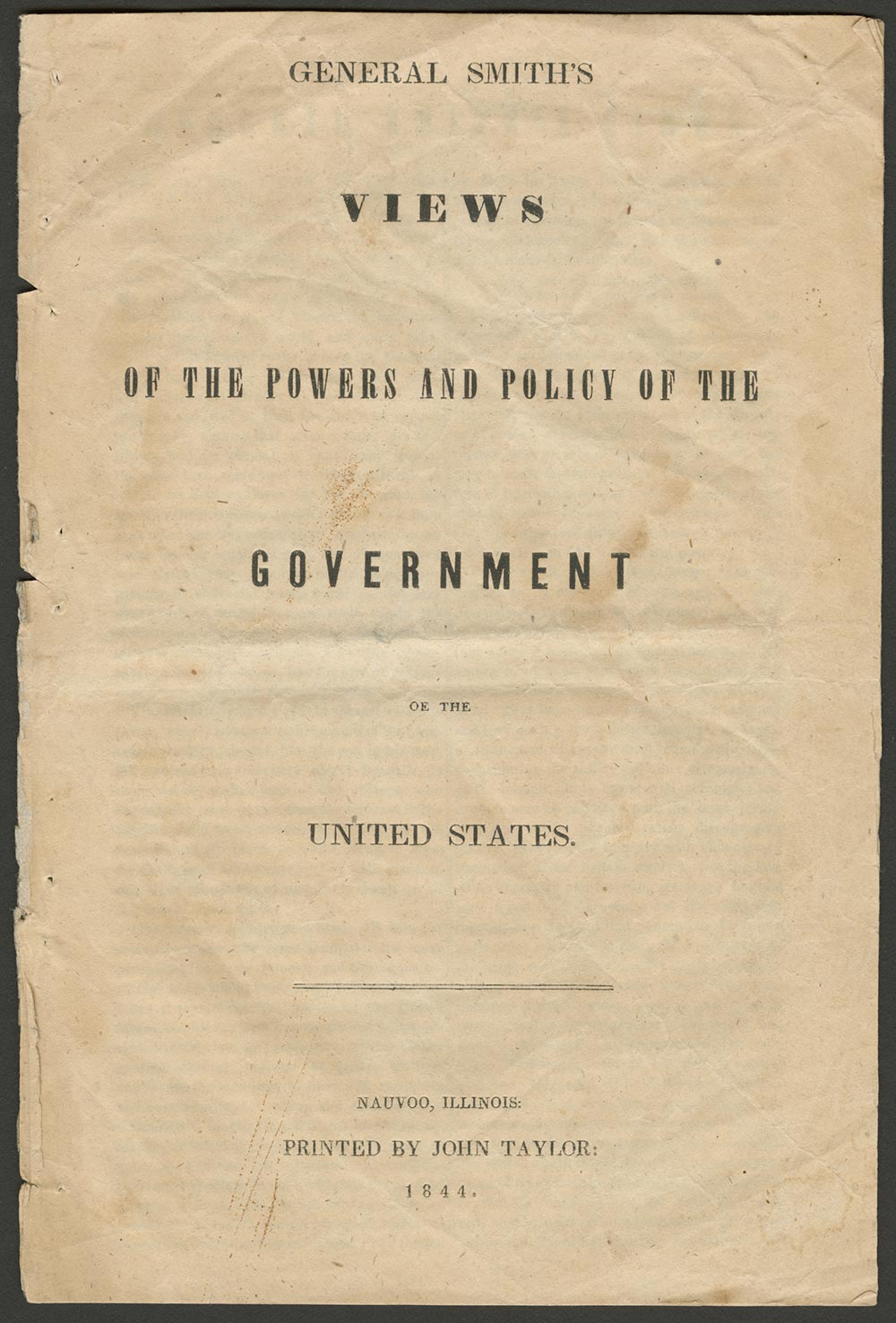 View 7 images
View 7 images
Joseph Smith Jr., General Smith’s views of the powers and policy of the government of the United States. Nauvoo, Illinois, Printed by John Taylor, 1844.
This pamphlet, essentially a statement of Smith’s views as a candidate for President of the United States, written February 7, 1844, suggests how he would deal with the question of slavery:
“... Wherefore, were I the President of the United States ... and when that people petitioned to abolish slavery in the slave states, I would use all honorable means to have their prayers granted, and give liberty to the captive by paying the Southern gentlemen a reasonable equivalent for his property, that the whole nation might be free indeed!”
William Lloyd Garrison
Few men or women worked harder or longer for the abolition of the slaves than William Lloyd Garrison. He was converted to the cause in the late 1820’s and immediately began printing and lecturing on the necessity of immediate abolition. In 1831, with the backing and support of Boston’s African-American community, Garrison founded The Liberator, an anti-slavery newspaper that would become one of the most influential and outspoken voices for abolitionism and women’s rights in the mid-nineteenth-century. Garrison continued to serve as the editor of the controversial newspaper until its last issue was printed in December 1865.
In 1831, Garrison helped found the New England Anti-Slavery Society, the first organization dedicated to the immediate abolition of slavery. The group proved so successful that two years later, Garrison and several other abolitionists met in Philadelphia to form the American Anti-Slavery Society. As the most prominent voice in the abolitionist movement, Garrison was called upon to write and print a declaration of the organization’s views and principles.
One of Garrison’s most influential followers was Frederick Douglass, a former slave. After Douglass, whose political philosophies had been forged through reading the Liberator, recounted his experiences at an anti-slavery rally in 1841, Garrison and others recruited him as a representative for the Massachusetts Anti-Slavery Society. He became of fixture of the abolitionist movement from that time on and in 1845 Garrison printed Douglass’s famous autobiography.
William Lloyd Garrison was a deeply spiritual man and he hoped that abolitionism could be brought about naturally and peacefully through a moral reform of the nation. As a confirmed pacifist he viewed the increasing violence and unrest leading up to the Civil War with some uncertainty. He hoped for a peaceful solution, but when violence came, as in 1859 with John Brown’s abortive slave revolt and insurrection at Harper’s Ferry, Virginia, Garrison felt that he was morally bound to side with the oppressed over the oppressor.
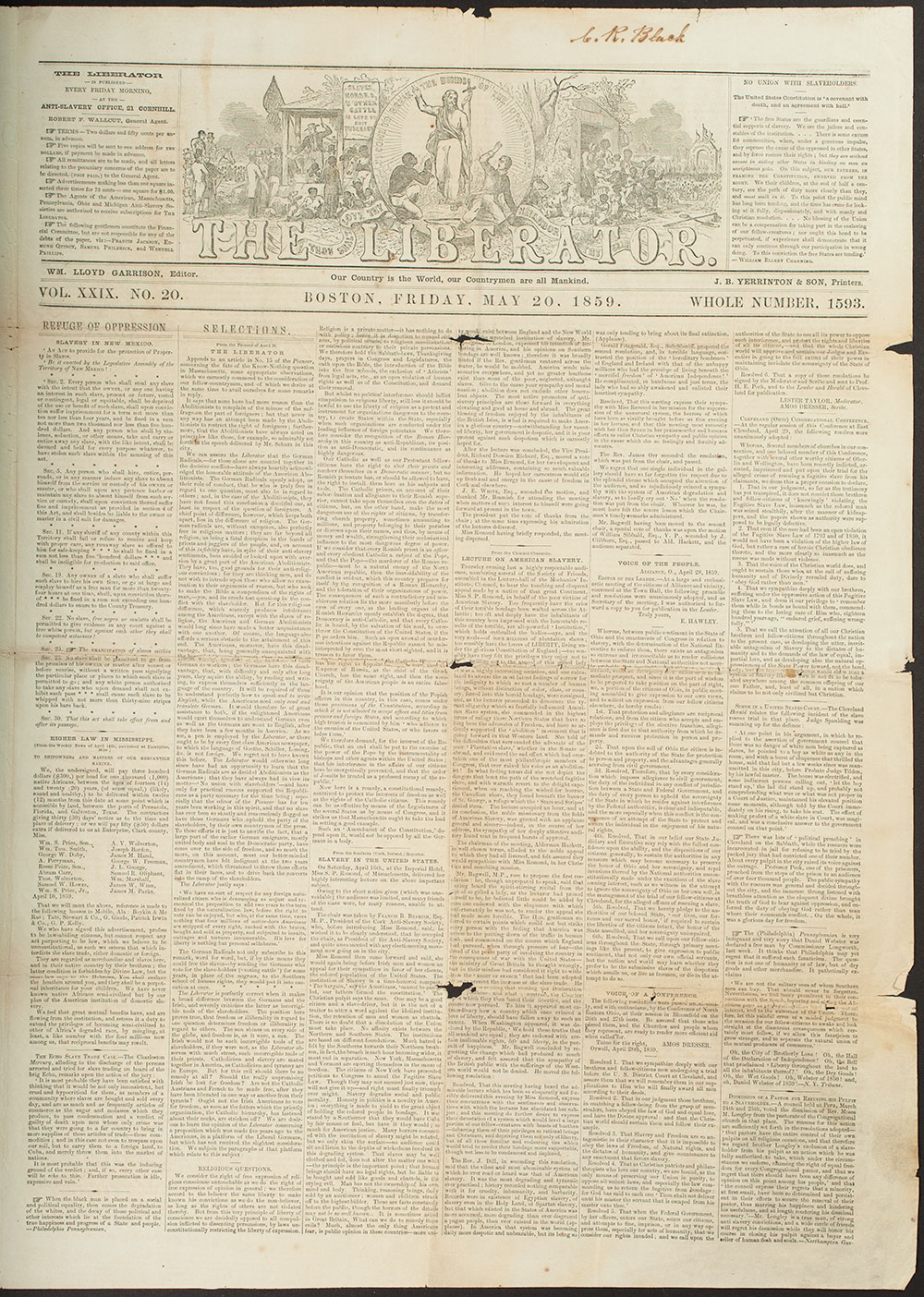 View 4 images
View 4 images
The Liberator. May 20, 1859 and November 2, 1860.
(Courtesy of Gregory and Susan Ramstedt)
 View 7 images
View 7 images
Declaration of Sentiments of the American Anti-Slavery Society.
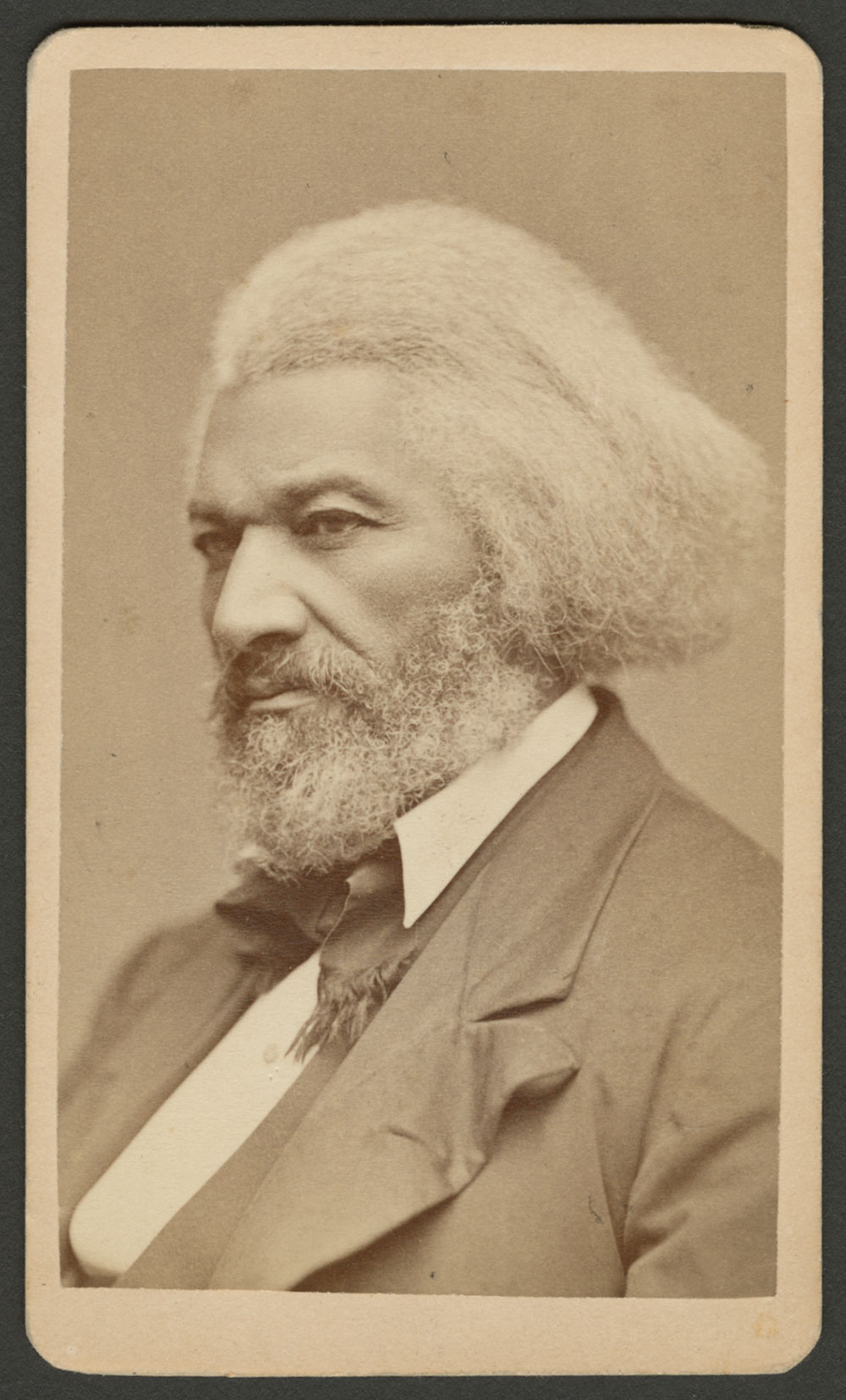 View 1 image
View 1 image
Frederick Douglass carte de visite
 View 1 image
View 1 image
John Brown engraving.
William and Annette Curtis collection of African Americana and church history materials (MSS 6223)